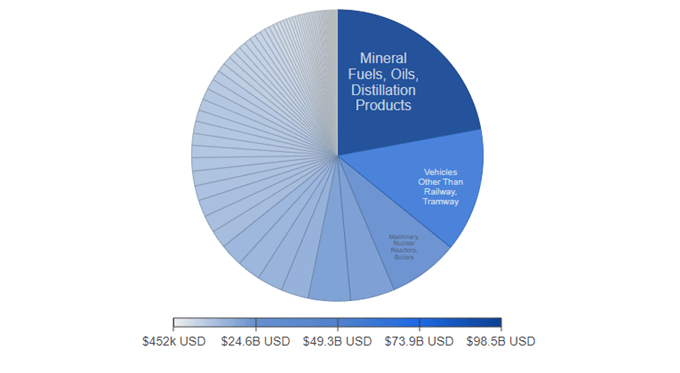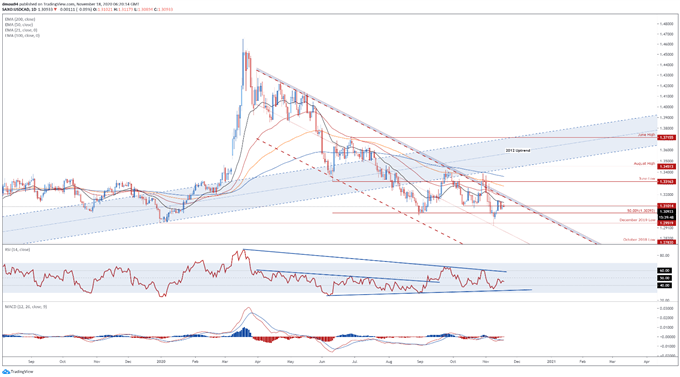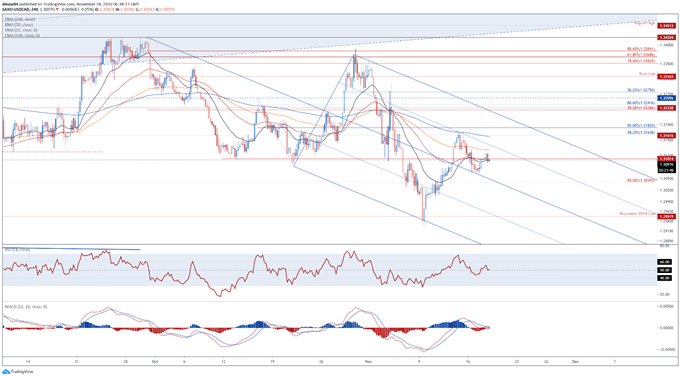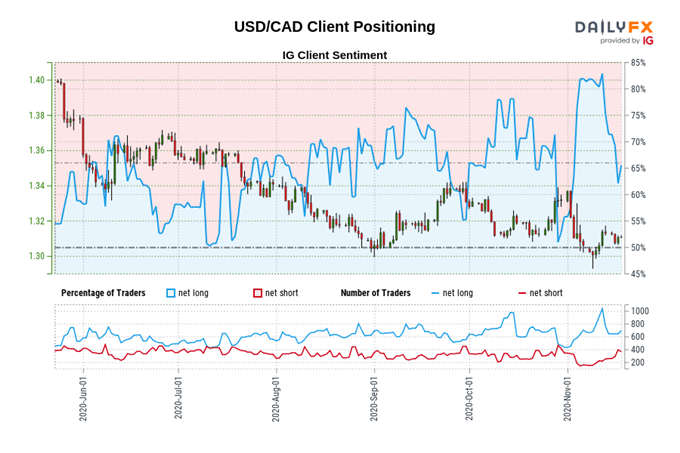Canadian Dollar, USD/CAD, Canada Inflation, Coronavirus Vaccine, BoC – Talking Points:
- Japan’s Nikkei plunged lower during APAC trade as Tokyo prepares to tight coronavirus restrictions.
- Resilient oil prices and vaccine optimism may continue to buoy the cyclically-sensitive Canadian Dollar.
- USD/CAD poised to extend primary downtrend.
Asia-Pacific Recap
A mixed day of trade in the Asia-Pacific session saw Australia’s ASX 200 index climb 0.51% on news that the Australian Prudential Regulation Authority is reconsidering its cap on bank dividend payouts.
Japan’s Nikkei 225 plunged 1.1% as Tokyo, the nation’s capital, prepares to tighten coronavirus restriction after recording a daily record of 493 new infections.
The haven-associated US Dollar continue to lose ground against its major counterparts while the Japanese Yen nudged marginally higher.
The cyclically-sensitive Australian Dollar lost ground after comments from Reserve Bank of Australia Phillip Lowe while the British Pound gained ground as negotiator edge closer to a Brexit deal.
Gold crept back above $1880/oz as yields on US 10-year Treasuries moved two basis points lower.
Looking ahead, inflation data out of the Euro-zone and Canada headline the economic docket alongside US building permit figures for the month of October.

Market reaction chart created using TradingView
Vaccine Optimism, Resilient Oil Prices Underpinning CAD
The Canadian Dollar may continue to push higher against the US Dollar in the near term, buoyed by a second set of positive coronavirus vaccine results and resilient crude oil prices.
Moderna’s clinical trial results showed that its vaccine was 94.5% effective in protecting people from Covid-19, a slightly higher level of efficacy than the vaccine developed by Pfizer and BioNTech. This has reinvigorated global growth bets in recent days and put a premium on cyclically-sensitive assets and sectors.
The promising news has also helped to underpin crude oil prices, with the commodity suffering from a significant drop in demand due to the tightening of coronavirus restrictions throughout Europe and in several US states.
Correlation Chart (YTD)

A panel of OPEC+ ministers may support crude oil prices further, if the committee moves to delay planned supply hikes by three to six months.
Although correlation is not causation, the positive relationship between oil prices and the Canadian Dollar is certainly one to note. After all, Canada’s most valuable export is crude oil, accounting for $98.5 billion of trade in 2019.
With that in mind, the commodity-linked currency may continue to track oil prices higher if the current risk-on market dynamic endures.

Source – Trading Economics
Upcoming Inflation Data Keenly Eyed
Upcoming inflation data may intensify the Loonie’s resurgence against USD, if consumer price growth exceeds market expectations. The core and headline inflation rates are expected to slip 0.1% lower in October.
However, a surprise to the upside could minimise the possibility of further easing from the Bank of Canada, given the central bank’s pledge to provide the “monetary stimulus needed to support the recovery and achieve the inflation objective”.
It was noted in previous reports that Governor Tiff Macklem has made his concerns regarding the impact of additional monetary easing well known, warning that “as much as bold policy response is needed, it will inevitably make the economy and financial system more vulnerable to economic shocks”.

Moreover, the BoC moved to gradually reduce its Quantitative Easing (QE) program’s total purchases to “at least $4 billion a week [and] shift purchase toward longer-term bonds” at its monetary policy meeting in October.
This policy adjustment, in tandem with Macklem’s warning, could be an indication that Canadian policymakers may resist easing further in the absence of a notable deterioration in economic data.
Therefore, investors may place a premium on the Canadian Dollar if upcoming economic data shows the trajectory of the nation’s nascent recovery is continuing to trend in the right direction.
USD/CAD Daily Chart – 21-DMA Guiding Price Lower

USD/CAD daily chart created using TradingView
The technical outlook for USD/CAD continues to favour the downside, as prices fail to breach the 21-day moving average (1.3131).
The development of the RSI and MACD indicator bolster the bearish outlook, as both oscillators track below their respective neutral midpoints.
Failure to close above support-turned-resistance at the October 12 low (1.3101) may ignite a pullback towards the 50% Fibonacci (1.3039). Pushing through that would probably open the door for price to challenge the yearly low (1.2928).
Alternatively, a daily close above the November 13 swing-high (1.3172) may neutralize short-term selling pressure and generate a push towards the 100-DMA (1.3276)
USD/CAD 4-Hour Chart – Poised to Extend Rebound

USD/CAD 4-hour chart created using TradingView
Zooming into a four-chart however, suggests USD/CAD may extend its rebound from the monthly low (1.2929), as prices burst away from Pitchfork median support.
Pushing through the 100-MA (1.3124) may set the stage for a run at confluent resistance at the 50% Fibonacci (1.3182) and the Pitchfork parallel.
A break above is required to invalidate downside potential and carve a path to retest key resistance at the June low (1.3316).
That being said, with prices tracking firmly below the sentiment-defining 200-MA, an extended topside push seems relatively unlikely.
Slipping back below the support range at 1.3060 – 1.3070 would probably signal the resumption of the primary downtrend and bring the psychologically imposing 1.3000 mark into focus.

Retail trader data shows 66.60% of traders are net-long with the ratio of traders long to short at 1.99 to 1. The number of traders net-long is 8.56% higher than yesterday and 22.49% lower from last week, while the number of traders net-short is 12.75% lower than yesterday and 54.11% higher from last week.
We typically take a contrarian view to crowd sentiment, and the fact traders are net-long suggests USD/CAD prices may continue to fall.
Positioning is more net-long than yesterday but less net-long from last week. The combination of current sentiment and recent changes gives us a further mixed USD/CAD trading bias.
-- Written by Daniel Moss, Analyst for DailyFX
Follow me on Twitter @DanielGMoss

